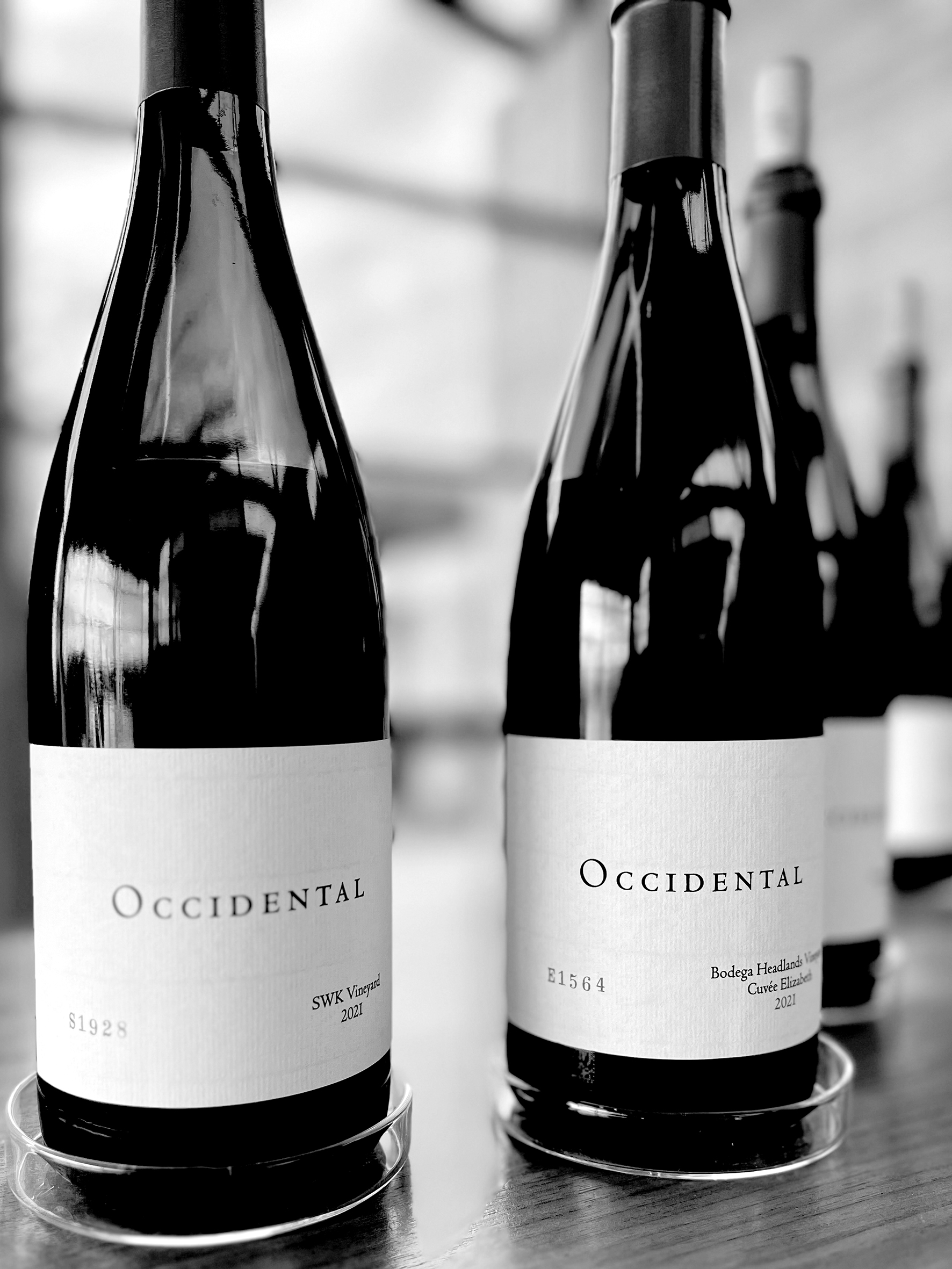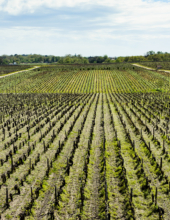18th Jan 2024
I took the opportunity to visit Steve and Catherine Kistler last week to taste the forthcoming Occidental releases. Given the greatness of this vintage in Sonoma and what the father/daughter winemaking team had told me about their 2021s last year, I expected that this quintet of wines would be worth the long drive out to the Bodega coast. I wasn’t disappointed.
Off the Charts
Steve Kistler’s pioneering spirit and pursuit of world-class Pinot Noir took him to the town of Occidental and beyond, with vineyards extending right out to the Bodega Headlands, within sight of the Pacific Ocean. The first vineyard sections for his Occidental label were planted by Steve in the early 2000s when few were even considering this now sought-after extreme coastal area. In 2017, Steve’s daughter Catherine joined him as assistant winemaker at the estate, poised to one day take over.
Kistler’s Occidental Vineyard sections are planted on a ridge line over the Pacific Ocean at 400–750-foot elevations facing south. The climate here is so cold and erratic that yields are usually painfully small. Two tons to the acre is a good haul. The maritime climate moderates the diurnal shifts (day and nighttime temperature differences) due to its proximity to the ocean. The growing season is consistently cool, but without the hot days and cold nights experienced further inland.

“The modest diurnal temperature variation allows the fruit to ripen slowly throughout the day as well as the night, a phenomenon experienced only in a true coastal environment,” said Steve. “This slow, steady ripening promotes the development of fruit that reaches true physiological maturity at lower sugar levels.”
The site is just one factor that makes Occidental unique. The other is the planting material. There was a little Calera clone initially planted here, but for subsequent plantings, Steve has focused more and more on the suitcase clones he acquired from two Grand Cru vineyards in Vosne Romanée in the early 1990s. The rootstocks are Riparia, which have a shorter vegetative cycle and maintain low yields.
"2021 was absolutely a dream vintage."
“2021 was absolutely a dream vintage,” Steve said as we sat to taste the upcoming releases. “2021 was the highest yield we’ve had. We averaged 2 tons per acre. The harvest was cool, and so we could really take our time. Our picking window was nice and wide—you could pick each block at its peak. For sorting, our fruit looked like caviar. The attention for detail we achieved in 2021 was incredible. We are careful not to break any berries going into the fermenter. When picking at night, there is naturally a lag time before fermentation begins. Most of the sugar is fermented at temperatures in the mid-80s (Fahrenheit). The technology with the de-stemmers is so different than it was twenty years ago. We don’t use many whole clusters, but the whole, intact berries are what’s important. That’s how you get the high-tone notes.”
"Each of the 2021 wines is so distinctly different."
The Occidental 2021 wines were bottled a year ago.
“Each of the 2021 wines is so distinctly different,” added Catherine. “But from the moment the berries enter the winery, they are treated exactly the same. The 2021 vintage comes across as a combination of 2018 and 2019. The wines are very chiseled and precise. They are developing like the ’18s but have that exuberance and fruit of the ’19s. They are still so salty and are evolving very slowly. The alcohols this vintage were all 13.3 or lower, and pHs were low; everything was perfect in 2021.”
I stopped in my tracks as I tasted SWK Vineyard Pinot Noir. The sheer scale of nuanced intensity in this Pinot is off the charts. Combined with the tension and level of tannin ripeness, the wine is mind-blowing.
"The 2021 SWK Vineyard is labeled 13-something alcohol, but it’s more like 12.8," smiled Steve.
Meanwhile, the Kisters are preparing to plant the new site they acquired in 2021. This virgin land is located 2.5 miles from the coast and on another of the headlands. The plan is to plant 50 acres, all Pinot Noir, using a massal selection of the suitcase clones from the existing Occidental sites.
“We’ll begin planting vines at the new property next spring,” said Catherine. “We’re developing the site in two phases. The rootstocks are being planted this Spring—all Riparia. The Riperia rootstock really works well here. We get less shatter, but we don’t know why. In 2025, we’ll graft onto the rootstocks. Last year, we built a reservoir at the new vineyard, which is already half full. This was completely bare ranchland—it is great to see it in every stage of development!”

Occidental’s Vineyards
Bodega Headlands Vineyard
Located at 400 to 750 feet elevation, the Bodega Headlands Vineyard is very close to the Pacific Ocean and exposed to strong prevailing coastal winds. The soils are primarily composed of fractured sandstone and decomposed marine sediments. Planted in 2000 to a proprietary blend of field selections from two grand cru vineyards in Vosne Romanée, according to Catherine Kistler, this vineyard tends to give flamboyant, perfumed wines with a fruit profile in red berry spectrum.
Running Fence Vineyard
Running Fence Vineyard and Bodega Ridge Vineyard are parts of the same 250-acre property, purchased in 2008, overlooking the Pacific Ocean. Sixty-five acres were planted in 2012. The soils are similar to the fractured sandstone soils found in the Bodega Headlands Vineyard next door but are freer draining and possess more gravel. The clonal material here is the same proprietary blend of field selections from two grand cru vineyards in Vosne Romanée. Occidental’s winery, completed in 2013, is located at this site. “The humus character really comes out in this wine,” said Catherine Kistler. “This is so earthy.”
SWK Vineyard
SWK Vineyard is an extension of the Bodega Headlands Vineyard, located at the upper northwest corner of this site, at the highest elevation of 750 feet. Planted in 2000 to a proprietary blend of field selections from two grand cru vineyards in Vosne Romanée, this site is dry-farmed (using no irrigation). It is Occidental’s coolest site with the poorest soils, offering the lowest yields. Often tightly knit in youth, the wines are highly structured with naturally low pHs while exhibiting intense flavors, usually of the red berry spectrum and with a profound perfume.
Bodega Ridge Vineyard
This vineyard is at the upper level of the Running Fence Vineyard, on the apex of the ridge overlooking the Occidental winery below and offering a magnificent view of the Pacific Ocean. Much of the vineyard is planted on steep south-southeast facing slopes, but there is a broad range of aspects here. The soils are shallow, low-vigor, marine-based sandstones with just enough water-holding capacity to be dry-farmed. The taut, muscular wine from here offers a darker fruit and earthy profile.
Occidental Station Vineyard
Occidental Station Vineyard is further inland from the other Occidental sites. It was planted by Steve Kistler in 1998/9. This 18-acre site is farmed by the Kistlers on a long-term lease. Composed of iron-rich, pebbly soils, this vineyard is dry-farmed and the first to ripen. Occidental Station Vineyard usually produces a bold, out-of-the-gate expressive, darker fruits style of wine.
-
Article, reviews & bottle shot by Lisa Perrotti-Brown MW
Photos by Johan Berglund

PRODUCERS IN THIS ARTICLE
> Show all wines sorted by scoreMore articles

Bordeaux 2023 Vintage Report and Reviews from Barrel
09th May 2024
649 tasting notes

Cathiard Vineyard New Releases
02nd May 2024
3 tasting notes

Bordeaux 2023 Preliminary Vintage Report and Reviews from Barrel
29th Apr 2024
56 tasting notes

2021 Bordeaux in Bottle and A Modest Proposal
24th Apr 2024
599 tasting notes
Show all articles